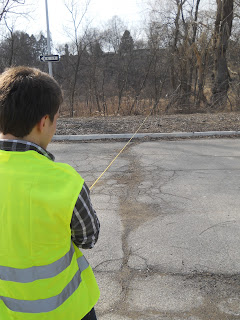Friday, March 9, 2012
Dear McMaster University Planning
Committee,
I am writing to follow up
on the issue of paving in McMaster parking lot “M.”
I had written to you
previously in March 2011 with concerns relating to the section of Lot M, closed
for the past three years due to construction of a Combined Sewer Overflow (CSO)
tank by the City of Hamilton. As well, I raised the issue of the entire parking
lot’s proximity to Ancaster Creek. I had asked that the campus master plan’s “minimum”
30 metre naturalized buffer zone between the creek and the parking be
administered to this area.
The May 10, 2011 response
from the committee through the Office of the Provost Vice-President (Academic) unfortunately
declared, “the demand for vehicular transportation continues and the need for
parking remains. We do, therefore, need to restore the parking Lot M” – on this
point I must vigorously disagree. As the recent “McMaster University Campus
Capacity Study” (April 2011) indicates, at the peak parking demand there are
2,803 spaces required out of a possible campus total of over 4,000 parking
spaces, which they indicate is 69 percent of the total available – thus, at the
busiest parking time there are well over 1,000 spaces that are not required. To
thus claim that we need to replace 225 spaces in the section of Lot M to be
repaved with permeable paving does not hold water, if I may rely on a pun to
make a point.
While the goal of using
permeable paving in McMaster parking lots is laudable, it makes no sense at all
to use paving of any kind where spaces are not required. To put it simply, it
would be a waste of money on land that could instead be restored to natural
habitat. To avoid the hollow and
ultimately tragic outcome of a green-wash, the university should resolve to
reject potential “innovation” and LEEDS points for this project when the more financially
responsible, sustainable and innovative answer is to restore habitat and
protect the creek.
If, instead, we had a plan
for parking that sought to actively reduce demand while shrinking the required
surface parking area, we would be able to engage students and faculty in
cutting edge research: in transportation demand management and habitat
restoration projects that would benefit the local environment and contribute to
McMaster’s reputation and the learning experience of students. Having
site-specific research opportunities on campus, McMaster could lead in environmental
innovation with positive spin-off benefits through increased job opportunities
for future engineering and environmental graduates.
 |
| Figure 1, recent set back from creek short of 30m |
If
the University is to adhere to its planning document requirement for a 30m
naturalized buffer, a plan to guide development is imperative. A recent increase
in set back from the creek in the parking area is still not close to a 30 metre
distance from the creek (Figure 1), so it would appear an initial attempt to
conform has fallen short. A comprehensive plan for parking based on actual data
would provide real opportunities to address social and environmental issues
attached to car use on campus.
McMaster’s history began
with a direct relationship between campus life and nature, and the fates of the
RBG and McMaster have always been entwined:
“The new university [is]. . . . right on the brink of a sylvan paradise. Its scholars will at their back door have cool ravines and marsh meadows in which to meditate the theological and other muses. . . . And they will have red-winged blackbirds and whistling swans and canorous Canada Geese to keep them company.” (Hamilton Spectator, Oct. 5, 1929)
We would like to remind you
that Lot M and the entire west campus was, until 1965, a nature sanctuary owned
by the Royal Botanical Gardens, with spring fed ponds and nature trails. So
when we read more recently that
“Sustainability is a focus of management of the campus, with stewardship of natural lands, forest, watershed and the urban landscape of primary concern. A haven of diverse ecosystems and wildlife, McMaster’s abundant natural lands provide a unique university setting, and opportunity for study” http://ppims.mcmaster.ca/pplant/aboutus.html
we feel compelled to push
for more than the University is offering in Lot M, which is currently less than
even the Campus Master Plan suggests. Over 1,000 vacant parking spaces at the
peak of demand does not fit with the vision of campus outlined here. As a
result, it is our position that
- no money be spent on resurfacing the section of Lot M marked for permeable paving.
- that a parking plan be undertaken with the comprehensive goal of reducing parking demand and reducing parking surface in the west campus parking lots to allow for habitat restoration
- that the minimum 30m naturalized buffer zone be exceeded so as to restore the natural integrity of the area adjacent to Ancaster Creek
- that university departments be encouraged to seek ways to provide assistance and offer research opportunities to rehabilitate this area, and where applicable with permeable paving.
Perhaps then we will be
giving life to the sentiment that “McMaster’s outstanding grounds, situated
adjacent to Cootes Paradise wetlands, and the Royal Botanical Gardens in the
Niagara Escarpment, is a key factor in attracting students, staff, and visitors
to campus.” (Ibid)
Thank you for your
attention to this pressing issue, and I hope a more satisfactory position will
be arrived at than previously indicated by the planning committee, given this
additional information.
In the spirit of
collegiality,
Randy Kay
Restore Cootes
PO Box 19, 1280 Main
Street West, Hamilton ON L8S 1C0
dundastard@gmail.com
restorecootes.blogspot.com

Comments